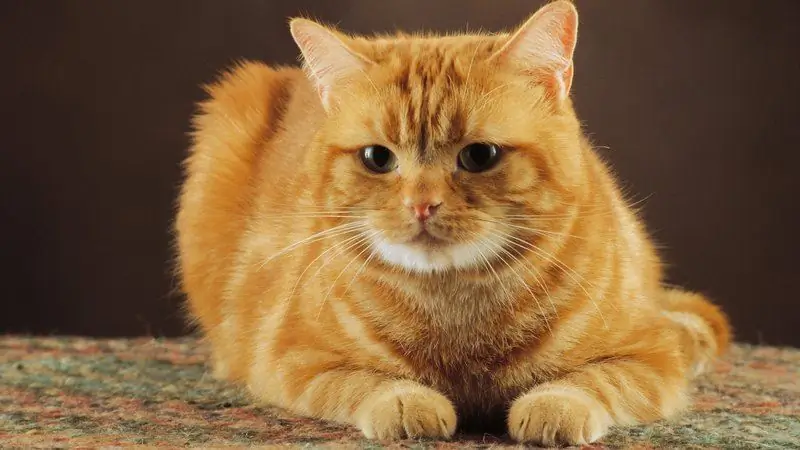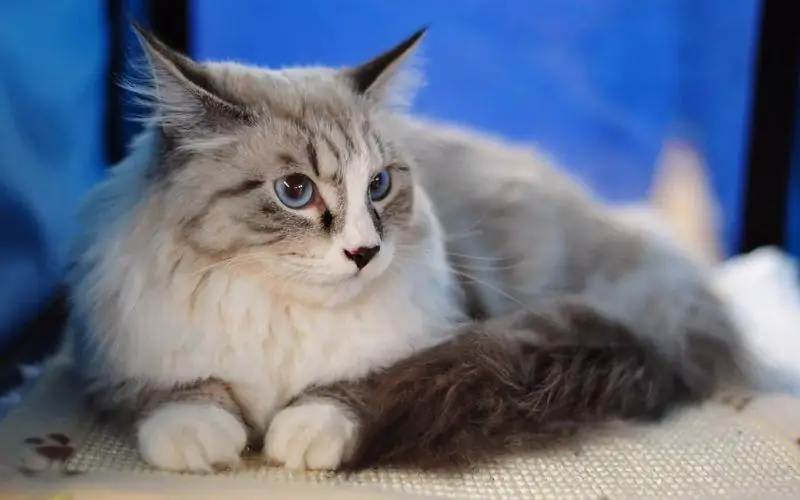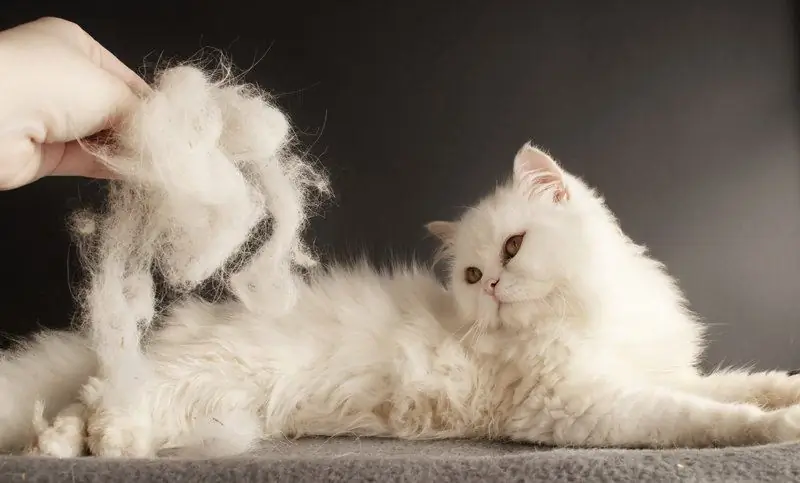
Table of contents:
- Purulent discharge from a cat's eyes: one symptom of many diseases
- What purulent discharge from a cat's eyes looks like
- What diseases can eyes fester?
- When a doctor is urgently needed
- Breed predisposition to purulent discharge from the eyes in cats
- Prevention of purulent discharge from the eyes in cats
- Veterinarian recommendations
- Author Bailey Albertson [email protected].
- Public 2024-01-17 22:26.
- Last modified 2025-06-01 07:32.
Purulent discharge from a cat's eyes: one symptom of many diseases

The reason for the appearance of purulent discharge from the eyes of a cat raises questions from its owner, and answers to them will be found after the pet is examined by a veterinarian.
Content
- 1 What purulent discharge from a cat's eyes looks like
-
2 For what diseases can eyes fester
-
2.1 General diseases accompanied by purulent discharge from the eyes
- 2.1.1 Photo gallery: systemic diseases in which purulent discharge from the eyes is observed
- 2.1.2 Measures to improve the condition of the conjunctiva
- 2.2 Table: eye diseases with purulent discharge
- 2.3 Photo gallery: eye diseases in which purulent discharge from the eyes occurs
- 2.4 Table: drugs that are used to treat eyes in cats with purulent discharge
- 2.5 Photo gallery for the treatment of eye diseases with purulent discharge
- 2.6 How to Treat Cat Eyes
- 2.7 Video: how to care for your pet's eyes
-
- 3 When a doctor is urgently needed
- 4 Breed predisposition to purulent discharge from the eyes in cats
- 5 Prevention of purulent discharge from the eyes in cats
- 6 Recommendations from veterinarians
What purulent discharge from a cat's eyes looks like
Purulent discharge from the cat's eyes is seemingly opaque, viscous, has a yellowish or greenish color, which determines the appearance of the microflora that caused the formation of pus. Depending on the amount of discharge, it can be located in the corners of the cat's eyes, form streaks on its muzzle and dry yellowish crusts, as well as form cloudy filmy overlays on the conjunctiva.
The appearance of the eye changes, the most common are:
- redness of the conjunctiva and eyelids;
- edema of the conjunctiva and eyelids;
- prolapse of the third eyelid in the affected eye;
- blepharospasm - narrowing of the palpebral fissure caused by the protective contraction of the eye muscles;
- photophobia - the cat squints the affected eye, being in the light, seeks to find darkened places.
Animal behavior changes:
- the cat scratches its eyes with its paws and rubs its muzzle against surrounding objects;
- blinks frequently;
- sneezes rarely if this is due to the ingress of part of the discharge into the nasal cavity through the nasolacrimal canal, and often - if purulent discharge from the eyes is associated with the development of an infectious disease;
- trying to hide in dark places;
- the cat is apathetic, does not want to play, his appetite decreases.

Purulent discharge is opaque, viscous, with a yellowish or greenish tinge
What diseases can eyes fester?
Purulent discharge from the eyes is a symptom of both eye diseases and general diseases.
Common diseases accompanied by purulent discharge from the eyes
Common diseases in which eyes fester in cats:
-
Allergy - at the beginning of the disease, the discharge is mucous, bilateral, which changes to purulent when secondary microbial flora is attached. Additionally observed:
- sneezing;
- discharge from the nose;
- redness of the conjunctiva;
- rash on the skin.
-
Helminthic invasions - with helminthic diseases, an allergic restructuring of the immune system occurs, the discharge is also bilateral. Additional symptoms:
- instability of appetite;
- weight loss;
- an increase in the size of the abdomen;
- alternation of diarrhea and constipation;
- deterioration of the coat;
- admixture of blood in the stool;
- anemia.
-
Infectious diseases:
-
panleukopenia:
- sudden fever up to 40-41 o C;
- pronounced general depression;
- nausea, vomiting mixed with mucus;
- thirst, but the cat does not drink water due to nausea;
- a rash on the skin (reddish spots are replaced by small vesicles with transparent discharge);
- diarrhea mixed with blood, constipation is also possible;
- purulent discharge from the nose;
- sneezing, coughing;
- dyspnea;
- heart rhythm disturbances;
- sudden death at the very beginning of the disease.
-
viral leukemia and viral immunodeficiency - their symptoms can be very similar, this is due to the defeat of the immune system by a virus:
- fever;
- thirst;
- general oppression;
- lack of appetite;
- diarrhea;
- ulcerative stomatitis;
- cough, sneezing, purulent discharge from the nose;
- shortness of breath with the development of pneumonia;
- pustular skin lesions;
- an increase in peripheral lymph nodes;
- anemia;
- development of tumor formations.
-
herpes:
- fever;
- sneezing, coughing discharge from the nose;
- ulcerative stomatitis;
- general oppression;
- shortness of breath with the development of pneumonia;
- clouding of the cornea of the eye with the development of keratitis;
- miscarriages and stillbirths in pregnant cats.
-
calicivirus:
- fever of a periodic nature;
- sneezing, coughing discharge from the nose;
- ulcerative stomatitis;
- shortness of breath with the development of pneumonia;
-
arthritis:
- swelling of the affected joint;
- painful movements in it, a decrease in their volume;
- redness of the skin over the affected joint.
-
chlamydia:
- at the very beginning of the disease, purulent discharge is unilateral, later the second eye is affected;
- fever at the onset of the disease, followed by temperature normalization;
-
chemosis - pronounced edema of the conjunctiva;

Conjunctival chemosis Chemosis is the predominant symptom of chlamydial conjunctival involvement.
- runny nose, sneezing, cough;
- shortness of breath with the development of pneumonia;
- infertility, miscarriages, stillbirth, decreased vitality of kittens;
- joint damage with the development of arthritis.
-
mycoplasmosis:
- fever;
- general oppression;
- runny nose, sneezing, cough;
- shortness of breath with the development of pneumonia;
- endometritis;
- cystitis;
- miscarriages and stillbirths in pregnant cats;
- arthritis.
-
-
Colds caused by the activation of a cat's own opportunistic microflora during hypothermia. Symptoms:
- sneezing, coughing;
- decreased activity level;
- decreased appetite;
- fever.
Photo gallery: systemic diseases in which purulent discharge from the eyes is observed
-

Purulent discharge from the eyes and nose of a kitten - With panleukopenia, there is abundant purulent discharge from the eyes and nose.
-

Abundant purulent discharge from the cat's eyes - With herpetic conjunctivitis, discharge from the eyes is purulent
-

Purulent discharge from the eyes and chemosis in a cat - With chlamydia, purulent discharge from the eyes is typical, as well as chemosis - conjunctival edema
Measures to improve the condition of the conjunctiva
With general diseases, purulent discharge from the eyes is treated only together with the underlying pathology, of which they are a symptom. To improve the condition of the eyes with common diseases, as part of complex therapy, the following are used:
-
Regular toilet of the eyes to remove pus and microbial accumulations using hygienic eye lotions:
- Wedges;
- Veda;
- Dewdrop.
- Human leukocyte interferon in viral diseases;
-
Antibacterial drops to eliminate secondary bacterial flora:
- Tsiprovet;
- Levomycetin.
-
Antibacterial ointments:
- tetracycline ophthalmic;
- erythromycin.
-
Eye drops with immunomodulators:
- Forvet;
-
Anandin.

Anandin eye drops Anandin is a drug that is endowed with anti-inflammatory, antiviral and immunomodulatory effects
Table: eye diseases with purulent discharge
| Type of disease | Symptoms | Treatment |
| Eye injury |
|
|
| Conjunctivitis - inflammation of the conjunctiva and eyelids, unilateral or bilateral |
|
|
| Keratitis - inflammation of the cornea |
|
|
| Blepharitis - inflammation of the eyelids |
|
|
| Uveitis - inflammation of the choroid |
|
|
| Twisting of the eyelid - chronic trauma to the surface of the eye by the edge of the deformed eyelid, as well as by its eyelashes |
|
Surgical restoration of the correct position of the eyelid |
| Dacryocystitis - inflammation of the lacrimal sac |
|
|
Thus, purulent discharge from a cat's eyes may indicate both the presence of a systemic disease and the development of an eye disease. Moreover, purulent inflammation can mask the primary nature of the process and return after the use of antibiotics without treating the underlying cause of the disease.
Photo gallery: eye diseases in which purulent discharge from the eyes occurs
-

Bilateral purulent discharge, narrowing of the palpebral fissure and prolapse of the third eyelid in a cat - Purulent discharge from the eyes in cats most often occurs with conjunctivitis
-

Clouding of the cornea of the eye in a cat - Corneal opacity is characteristic of keratitis
-

Dacryocystitis in a cat - With dacryocystitis, swelling is determined at the inner corner of the eye
-

Twisted eyelids in cats after surgery - Invasion of the eyelid is treated surgically
Table: drugs that are used to treat eyes in cats with purulent discharge
| A drug | Structure | Operating principle | Application | Price, rubles |
| Ophthalmosan, eye drops |
|
Bactericidal, anti-inflammatory, decongestant |
|
185 |
| Bars, eye drops |
|
Antibacterial agent |
Instill 1-2 drops 3-4 times a day for a course of 1-2 weeks. |
159 |
| Tsiprovet, eye drops | Ciprofloxacin | Antibacterial agent |
Instill 1 drop 4 times a day for 1-2 weeks. |
196 |
| Tetracycline eye ointment | Tetracycline | Antibacterial agent | Infectious diseases of the eyes caused by pathogens sensitive to tetracycline. Apply 3-5 times a day. | from 44 |
| Maxidine 0.15, eye drops | Bis (pyridine-2,6-dicarboxylate) germanium |
|
Treatment of conjunctivitis and keratoconjunctivitis. Apply 1 drop 2-3 times a day for a course of no more than 2 weeks. | 52 per bottle |
Photo gallery for the treatment of eye diseases with purulent discharge
-

Sinulox - Sinulox is used for systemic antibacterial therapy for infectious eye diseases
-

Tetracycline eye ointment - Tetracycline ointment has a wide spectrum of action and is used to treat both bacterial conjunctivitis and chlamydia
-

Bars, eye drops - Eye drops Bars - a combined antibacterial drug with an extended spectrum of action
-

Korneregel - Korneregel promotes corneal healing
-

Maxidine - Maxidin (Maxidin) is a veterinary drug that is used for immunocorrection in the fight against diseases of viral origin
-

Decta-2 - Eye drops Dekta-2 are intended for the treatment and prevention of ophthalmic diseases of bacterial origin in pets
-

Ciprovet tablets for cats - Ciprovet for cats is an effective antibacterial drug with a complex spectrum of action
How to Treat Cat Eyes
For medical procedures, it is better to use the help of an assistant who would hold the cat. If there is no assistant, the cat is immobilized by swaddling with a towel.
The following treatment procedures are carried out at home:
-
Eye wash:
- the napkin is moistened with eye lotion or an antiseptic solution and carried over the closed eyelids, removing the discharge;
- if the eyelids are stuck together, they apply and lightly press a napkin abundantly moistened with an antiseptic solution, after which the eye will open, you cannot use force to open the eye, you can damage the eyelids;
- it is impossible to touch the surface of the eye with a napkin; it is washed with an antiseptic solution from a syringe, after removing the needle.
- Instillation - the medicinal solution is instilled into the lower conjunctival pocket, bending the edge of the lower eyelid. After that, the eyelids are closed, contributing to an even distribution of the drug.
- Ointment applications - the ointment is also placed in the lower conjunctival pocket. It is better to apply it with your finger, since a glass rod or a spatula can easily injure the eye with a sharp movement of the cat. Before applying the drug, cleanly washed hands are treated with a chlorhexidine solution.
Since the ointments and drops are irritating, it makes sense for the cat to wear a protective (Elizabethan) collar to prevent the paws from scratching the eyes.

Protective collar to prevent paws from scratching your eyes
Video: how to care for your pet's eyes
When a doctor is urgently needed
A doctor is needed in all cases of the presence of purulent discharge from the eyes, when its cause is not obvious, and when purulent discharge persists for more than 2-3 days. In some situations, you should rush to a visit to the veterinarian, this is indicated by the symptoms:
- the appearance of a fever;
-
violation of general well-being:
- lethargy;
- apathy;
- decreased appetite.
- nausea, vomiting;
- diarrhea;
- ulcerative stomatitis;
- sneezing, runny nose, cough;
- dyspnea;
- plentiful character of purulent discharge;
- pronounced redness of the conjunctiva and its edema;
- discoloration of the iris;
- clouding of the cornea.

A doctor should be consulted in all cases when the cause of purulent discharge from the eyes of a cat is not obvious.
Breed predisposition to purulent discharge from the eyes in cats
In brachycephalic cat breeds, there is a predisposition to the appearance of discharge from the eyes, including purulent ones. This is due to the structural features of the skull. The nasolacrimal canals in these rocks are narrowed and curved, which contributes to a delay in the outflow of tear fluid and the occurrence of secretions. In addition, the structure of the bones of the skull predisposes to the presence of chronic inflammation in the upper respiratory tract, which facilitates the infection of the ocular discharge and the acquisition of a purulent character.
These breeds include:
- Persian;
- Himalayan;
- exotic shorthair;
- British;
- Scottish.
Some cats of these breeds require regular eye care from their owner in order to prevent pus.

Brachycephalic breeds of cats are predisposed to the development of purulent discharge from the eyes.
Prevention of purulent discharge from the eyes in cats
Measures to prevent the appearance of purulent discharge from the eyes in cats include:
- regular routine vaccination;
- preventive intake of anthelmintic drugs once a quarter;
- timely detection and treatment of chronic diseases and allergic conditions;
- preventive examinations of a veterinarian;
- protecting the cat from hypothermia;
- exclusion of contacts with stray animals;
- providing quality cat nutrition;
- regular wet cleaning of the premises where the cat is kept;
- monitoring the condition of the cat's eyes.
Veterinarian recommendations
Purulent discharge from the eyes in cats is a symptom of both general diseases and eye diseases. With a combination of purulent discharge from the eyes with any symptoms indicating a violation of general well-being, an appeal to the veterinarian should be urgent. If the cause of purulent discharge from the eyes is not obvious, self-medication with the use of veterinary drugs can be a thankless task and result in only a temporary improvement in the condition of the eyes, as well as a loss of time to start therapy for a systemic disease.
Recommended:
A Cat Or A Cat Pees With Blood: The Reasons For The Appearance Of Blood Urine In Kittens And Adult Animals, With What It May Be Connected, How To Treat

What does an impurity of blood in urine look like in a cat, types of hematuria, causes, list of diseases, diagnostic methods, first aid measures, prevention
One Or Both Eyes Of A Cat Or Cat Are Watering: Why, What To Do And How To Treat A Kitten And An Adult Animal At Home

Lachrymation in cats looks like it is formed. Causes of lacrimation in a healthy and sick pet, breed predisposition. Prevention
Why Does A Cat Or Cat Shed Heavily And What To Do If The Hair Climbs And Falls Out In Large Quantities In A Kitten And An Adult Animal

How is molting in cats normal? Features in different breeds. How to help a cat with normal and prolonged molting. Diseases manifested by abundant molting
How To Clean The Ears Of A Cat Or A Cat At Home, Than To Clean Them For An Adult Animal Or Kitten For Preventive And Therapeutic Purposes

Causes of ear contamination in cats. Common ear diseases, what care products to use, how to protect yourself from a cat while cleaning your ears
DIY Toys For Cats And Cats: How To Make At Home, What Accessories To Prefer For A Kitten And An Adult Animal

The need for toys in a cat's life, types of homemade toys and their phased production at home
